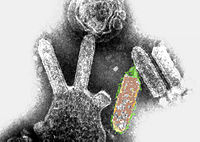
Photo from wikipedia
Dental care–related fear and anxiety (DFA) is prevalent, affects oral health care utilization, and is related to poor oral health and decreased quality of life. In addition to learned and… Click to show full abstract
Dental care–related fear and anxiety (DFA) is prevalent, affects oral health care utilization, and is related to poor oral health and decreased quality of life. In addition to learned and cultural factors, genetics is hypothesized to contribute to DFA. Therefore, we performed a genome-wide association study to identify genetic variants contributing to DFA. Adult and adolescent participants were from 4 cohorts (3 from the US-based Center for Oral Health Research in Appalachia, n = 1,144, 1,164, and 535, and the UK-based Avon Longitudinal Study of Parents and Children [ALSPAC], n = 2,078). Two self-report instruments were used to assess DFA: the Dental Fear Survey (US cohorts) and Corah’s Dental Anxiety Scale (ALSPAC). Genome-wide scans were performed for the DFA total scores and subscale scores (avoidance, physiological arousal, fear of dental treatment–specific stimuli), adjusting for age, sex, educational attainment, recruitment site, and genetic ancestry. Results across cohorts were combined using meta-analysis. Heritability estimates for DFA total and subscale scores were similar across cohorts and ranged from 23% to 59%. The meta-analysis revealed 3 significant (P < 5E-8) associations between genetic loci and 2 DFA subscales: physiological arousal and avoidance. Nearby genes included NTSR1 (P = 3.05E-8), DMRTA1 (P = 4.40E-8), and FAM84A (P = 7.72E-9). Of these, NTSR1, which was associated with the avoidance subscale, mediates neurotensin function, and its deficiency may lead to altered fear memory in mice. Gene enrichment analyses indicated that loci associated with the DFA total score and physiological arousal subscale score were enriched for genes associated with severe and persistent mental health (e.g., schizophrenia) and neurocognitive (e.g., autism) disorders. Heritability analysis indicated that DFA is partly explained by genetic factors, and our association results suggested shared genetic underpinnings with other psychological conditions.
Journal Title: Journal of Dental Research
Year Published: 2022
Link to full text (if available)
Share on Social Media: Sign Up to like & get
recommendations!